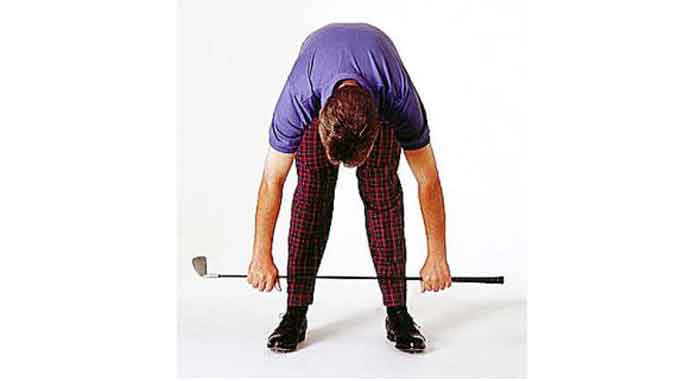
Baby Boomer New Year Fitness Guide Off Season Golf Training –
Exercises to Improve Your Score
by Robert Bresloff
With summer waning and fall nearly upon us, it’s almost time to clean the past season off those mighty clubs and put them away.
But wait! There is one piece of golf equipment that shouldn’t be tucked away in the closet – you!
Don’t put yourself in storage like those beloved clubs; offseason training might be exactly what you need to improve your game.
So let’s take a look at some Golf Exercises that just might improve your score.
Balance:
All sports performance is based on balance and stability. The mid-course correction muscles keep the body stabilized throughout the swing. They compensate as the weight shifts from the swing phase into the follow-through. What keeps your body from falling forward or the direction of the swing? Balance! If you improve your balance you will be far more stable during your swing.
One simple way to improve balance during your swing is to stand on a two-by-four (I recommend getting a better grade board for straightness) with your feet across and centered on the board. Assume the stance you use when teeing off. First, work on balancing on the board without falling.
Once you can perform that successfully, practice your swing while balancing on the board. If you can swing and follow through without wobbling or falling off, just think how stable you’ll be with your feet planted on terra firma.
Core:
The core is made up of the abdominal muscle groups and the muscles of the lower back. These muscles are pretty much of what holds us together. The stronger your midsection is, the more powerful your swing will be resulting in longer drives without overswinging.
Try two sets of crunches three times per week. Lie on your back with your feet up on a chair or bench so your knees are over your belt line. Tuck your chin and place your arms across your chest. Slowly raise your shoulders toward your knees as you press down lightly on the bench with your heels, then return to the starting position. Do as many repetitions as you can. Work up to fifteen repetitions per set.
When you can perform two sets of fifteen reps, try holding the crunch at the top of the movement rotating your upper torso as if trying to touch your left shoulder to your right knee. Return to the start position and repeat, this time rotating in the opposite direction. This will start to burn quickly so just do as many as you can—again working up to fifteen repetitions. Remember, golf is a sport of rotations: torso, shoulders, and hips.
Joints:
Now let’s work on your rotational joints. When the body performs a function, like playing golf, the hips and shoulders move in a series of rotations and diagonal angles. Frankly, most equipment at your health club probably won’t help you accomplish this. Don’t give up your membership at the Y just yet.
Take a look around the workout area; my guess is that there are free weights, pulley machines or exercise tubes. Many health clubs now have free motion equipment. These machines can be invaluable in training for golf (they allow you to work your joints through all planes of movement unlike standard plate-loaded machines).
Some great exercises for the shoulder and hip stabilization are external shoulder rotations, horizontal shoulder abduction (reverse fly), shoulder extensions, hip extensions, light squats, hip abductions, and hip adductions. Ask one of the attendants or trainers for assistance. They should be able to show you how to perform these movements on the type of equipment mentioned above.
Weights:
When lifting weights, always start light, it only takes a small increase in strength to improve your game. Make sure when performing upper body exercises to stabilize your shoulder girdle by pulling your shoulders back and down before performing each exercise.
When working the hips, make sure your hips are stable. Keep your back nice and straight and your core tight. Try two sets of each exercise two to three times per week. Finally, don’t get frustrated, especially with balance training. Be patient, it will come, and when it does, I think you’ll see a noticeable improvement in your game.
Fore!
Robert Bresloff is a Certified Personal Trainer, Fitness Therapist, Adaptive Fitness Specialist, a Specialist in Fitness for Older Adults, and Endurance Trainer with The International Sports Sciences Association. He owned and operated, Total Fitness Concepts Inc for 10 years. He has written for Masters Athlete Magazine, The Waukegan News Sun and trade e-magazines and recently released his first fitness book, ‘The Baby Boomer’s Guide to Fitness”





